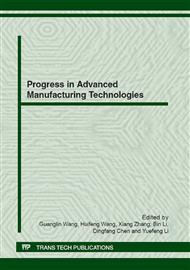p.240
p.245
p.251
p.256
p.260
p.264
p.268
p.272
p.278
Analysis of Affecting Factors on Allowable Contact Stress of Four-Point-Contact Slewing Rings with Single Row
Abstract:
In this paper, some experiments was implemented for analyzing the affecting factors on allowable contact stress of four-point-contact slewing rings with single row including the hardening depth, hardness and the osculation between the steel ball and the raceway. Firstly, the common material 42CrMo was chosen and heat-treated with some process of heat treatment for getting different hardening depth. And then, the indentation tests were conducted with the test-rig, followed by the data process. Finally, some conclusions can be obtained by comparing and analyzing the data. It concludes that when the hardening depth beyond 0.3 and the hardness is not lower than 57HRC, a better allowable contact stress can be got, besides, the better osculation 0.52 is better for the load capacity.
Info:
Periodical:
Pages:
260-263
Citation:
Online since:
August 2012
Authors:
Keywords:
Price:
Сopyright:
© 2012 Trans Tech Publications Ltd. All Rights Reserved
Share:
Citation:


